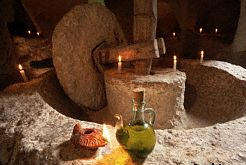
Spanish olive oil historyLegend has it that once upon a time a dispute
arose between the god Neptune and the goddess Minerva because of
the power of Atica. Jupiter decided that he would give the power
to whoever presented him the most useful gift for humanity. The
dispute was resolved in favour of the goddess when she presented
a branch asserting that it would become a strong tree, capable of
living for centuries and centuries, and that not only would its
fruits be good to eat, but furthermore, it would produce an extraordinary
liquid that would serve to adorn the food of men, to alleviate their
injuries, to give force to their bodies and light to their night.
Such was the importance of the Olive in the ancient World that Olive
tree branches were placed in the tombs of the pharaohs of ancient
Egypt, and as Andalucia was one of the most important olive oil
production areas in the Roman Empire, an olive tree branch became
the symbol of hispanic Rome. Spanish olive cultivationOlive cultivation and olive oil processing are inextricably linked to the history of Spain. The Phoenicians and Greeks originally introduced the olive tree Olea Europea into Spain. Later on the Romans expanded its cultivation and improved upon olive oil production techniques. It is not known exactly when cultivation of the olives began in Spain, however probably the oldest reliable reference to the cultivation of olives in Spain may be found in the book De Bello Hispanico, which describes the landscape of the territories during Julius Caesar's campaigns. The book relates an anecdote about Caesar's cavalry set in an olive tree plantation close to Sevilla, thus giving written evidence of olive tree plantation in Andalucia in the 1st century BC. Archaeological evidence found in the excavations at Monte Testaccio indicate that over a period of two hundred sixty years or so, Rome imported some six billion five hundred million litres of olive oil of olive oil, of which 85% was produced in Andalucia. Olive and olive oil production continued to grow during the Moorish occupation, surviving the ravages and devastation of many wars. Olives were later taken to the New World by Spanish settlers during the 16th and 17th centuries, and are now established in many former colonial areas, most notably California and South America. Spanish olive oilSpain has a surprising variety of climates and microclimates. These geographical conditions and the large number of olive varieties used to produce Spanish olive oils mean that there is a far wider range of aromas and tastes amongst Spanish oils than amongst those of any other oil producing nation . Some Spanish oils taste sweet and smooth, whereas others have great body and character with a varying intensities of a pleasant bitterness or pungency. Spanish olive oils usually have an intense fruity aroma reminiscent of green or ripe olives. Today, Spain is the world's leading producer of quality olive oil; it is estimated that there are over 215 million olive trees in Spain, covering over 5,000,000 acres. This amounts to over 27% of the world's olive production acreage. Spain has an average annual production of over 600,000 metric tons of olive oil. Of all oils used for human consumption, olive oil is the only one extracted from a fresh fruit, and its aroma and taste are clearly reminiscent of the olive fruit. The characteristics of olive oil changes according to the variety of olive used, and the climate and soil conditions. A large number of olive varieties are used in the production of Spanish olive oils, the most representative being the Picual, Hojiblanca, Lechin, Cornicabra, Verdial, Picudo, Arbequina, and Empeltre varieties. A single variety usually predominates in each of the main producing areas. Spanish olive oil links: Olive
oil history | Olive
oil |
|
